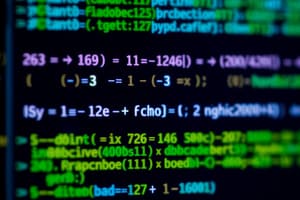Podcast
Questions and Answers
________ uses letters and symbols to represent relations and operations.
________ uses letters and symbols to represent relations and operations.
Relational algebra
Which of the following is a unary relational operation?
Which of the following is a unary relational operation?
- SET DIFFERENCE
- PROJECT (correct)
- UNION
- INTERSECTION
Which of the following is a unary relation operation?
Which of the following is a unary relation operation?
- SELECT (correct)
- UNION
- JOIN
- SET DIFFERENCE
Which of the following is a binary relation operation?
Which of the following is a binary relation operation?
Which of the following is a binary relational operation?
Which of the following is a binary relational operation?
_________ is the theory behind all SQL statements.
_________ is the theory behind all SQL statements.
The _________ operation is used to retrieve rows of data that meet certain conditions from a relation.
The _________ operation is used to retrieve rows of data that meet certain conditions from a relation.
Which SQL statement is equivalent to the following relational algebra expression? σ Product?
Which SQL statement is equivalent to the following relational algebra expression? σ Product?
The _________ operation is used to retrieve columns of data from a relation.
The _________ operation is used to retrieve columns of data from a relation.
Which SQL statement is equivalent to the following relational algebra expression? Deliveries?
Which SQL statement is equivalent to the following relational algebra expression? Deliveries?
The RENAME operation can only be used to rename relations/tables.
The RENAME operation can only be used to rename relations/tables.
The RENAME operation is often used together with the relation assignment operator.
The RENAME operation is often used together with the relation assignment operator.
Flashcards are hidden until you start studying
Study Notes
Relational Algebra and SQL Operations
- Relational algebra employs symbols and letters to express relations and operations.
- The PROJECT operation is a unary relational operation that retrieves specified columns from a relation.
- SELECT is also a unary relational operation, focusing on retrieving rows that meet defined criteria.
- SET DIFFERENCE represents a binary relational operation used to find the difference between two relations.
- UNION, another binary relational operation, combines results from two relations.
SQL Foundations and Concepts
- Relational algebra serves as the theoretical foundation for all SQL statements.
- The SELECT operation in SQL is responsible for retrieving data rows that fulfill certain conditions.
- The SQL equivalent of relational algebra queries is crucial for translating operations effectively.
- PROJECT in SQL correlates to the retrieval of specific columns from a database table.
SQL Statement Equivalents
- SQL statements can mirror relational algebra expressions; understanding these equivalents is essential for effective database querying.
- Example of equivalent SQL for a relational algebra operation: SELECT * FROM Products WHERE SupplierId = 3 matches the algebra expression σ Products with the condition on SupplierId.
RENAME Operation
- The RENAME operation is versatile; it can rename not just relations/tables but also other entities in the database.
- Often used in conjunction with relation assignment operators, enhancing the manageability of database structures.
Key Concepts to Remember
- Unary operations involve a single relation (e.g., SELECT, PROJECT).
- Binary operations involve two relations (e.g., UNION, SET DIFFERENCE).
- Understanding relationships between relational algebra and SQL is crucial for database management and querying tasks.
Studying That Suits You
Use AI to generate personalized quizzes and flashcards to suit your learning preferences.




